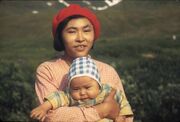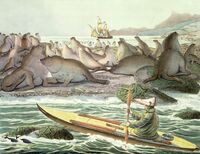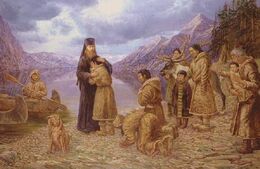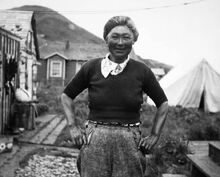
|
The following Russian America page or section is a proposal.
It has not been ratified and is therefore not currently part of the Russian America timeline. You are welcome to correct any errors and/or comment on the talk page. If you add this template to an article, please don't forget to mention this proposal on the main discussion page. |

An Aleut mother and child (1941).
Alaskan Indians (Russian: аляскинские индейцы, alyaskinskiye indeytsy) are the indigenous peoples of Alaska. The first Alaskan Indians migrated from Asia around 18,000 years ago when Asia and North America were connected by a land bridge. Alaskan Indians currently form the largest group in two governorates — Aleutia and the Far North. The Alaskan federal government formally recognizes over 50 tribes.
According to the 2007 Census, roughly 5% of the population identified as Alaskan Indians, with most Alaskans of Asian and European descent having some native heritage.
Etymology
Alaska formally uses the term Alaskan Indian in reference to all indigenous groups. The Russian-use of the name "Indian" was borrowed from the United States, which itself was coined by Christopher Columbus (who mistook the Americas for India). In the Russian language, the name is indeyets (индеец). It should be noted that this name is grammatically distinct from the name used to denote those from India — indiyets (индиец).
Prior to Alaska's independence, the Russian Empire colloquially recognized three native groups: Aleuts, Eskimos, and Indians. This distinction was attributed to Russia's early contact with the native people of the Bering Sea (who were clumped together with Siberians). Contact with the native peoples of the Alexander Archipelago (and beyond) would not take place until the late 18th Century. This ethnographic distinction remains in partial use to this day.
Presently there is a movement from Indians and Academics for official records to change terms to simply "original nations" or "aborigines" but this has not occurred. Opposition to a possible new name for Alaskan Indians say this would rob of Alaskan Indians of their identity as the natives of Alaska despite Indian statements to the contrary.
Classification
Alaska's Indians are diverse in dozens of language families and Ethnic groups. For purposes of anthropology and historiography they are commonly put into five cultural zones by Alaskan and Russian experts. Examples are placed in parentheses but they by no means denote every single tribe in their respective categories.
Arctic (Inuipat, Aleut, Alutiiq)
Interior Athabaskan (Na'dene)
Maritime Temperate group (Tlingit, Haida, Shimashan)
Somonan Chaparral (Pomo)
History
Early Contact

First encounter between Russians and Aleut Fishermen, 1741
Upon the first contact between Russians and Alaskan Indians in 1741 there would have at least half a million people in the whole territory that is now Alaska. Societies and economies varied greatly between the different native tribes, however they were all remarkable for their reluctance to use agriculture compared to natives in Mexico and the Eastern United States. Fishing was the most common activity in many tribes with landlocked natives relying on hunter gathering. Tribes farther south tended to have more complex rituals and society due to having more resources, throughout the country there was generally as system of coastal natives dominating interior peoples.
Epidemics killed many natives in almost all contacts between Russians and Indians. Relations between Russians and natives varied between violence and cooperation, native Tlingit people almost drove Russians away in 1804.In The first forty years of actual colonization (1780-1820) Russians were reliant upon native peoples, particularly Aleuts as a colonial workforce. Until the Russo-Spanish war many natives in the territory claimed by Russia were unknown to Europeans.
Cooperation

St. Tikhon, bidding farewell to Athabaskans
As larger scale Russian settlement of Alaska began after 1810 relations between Indians and colonists varied greatly between different areas of Russian Alaska. Southern Alaskan territories in Oregon and Sonora enjoyed peaceful coexistence and cohabitation but there was war in territories father north.
In early Fort Ross, Elizabeth Kuskova wife, of Russian American company administrator Ivan Kuskova bridged the colony with the Pomo people. Elizabeth taught herself the Pomo language and became the chief translator between the natives and the colonists. Often visiting Pomo villages she learned about the land and what could be grown contributing to the success of Fort Ross as a breadbasket. Elizabeth came to admire the native peoples for their cohabitation with the natural world and encouraged good treatment of the Pomo by her husband's associates. She founded a Russian Orthodox School that exists into the present
The onset of war with Spain sparked tensions between the settlers and Chaparral Indians as incoming soldiers did not respect earlier treaties, often stealing food and supplies for the war effort. After the war the increasingly pressured Pomo had to assimilate into colonial society, many taking on Russian names and customs. Other Pomo however, resisted and fled into the Rocky Mountains. In 1831 on orders of the administrator of the Russian American Company a plot of reserved land for the Pomo was granted to be accompanied by secular advisers and Orthodox priests. While more open to ethnic Europeans today the reserved land continues to hold autonomous status within the governate of Sonora.
The Great Tlingit War

A bust from the New Archangel museum of History
Despite insistence by several czars for good treatment of native peoples there were several outbreaks of violence in North Alaska. The Tlingit as the traditional center of power in the region were the most resistant to colonization. Even after 1804 eviction of Tlingit from New Archangel colonies in Tongass and Yakut were always on the the defensive from annual attacks from the prosperous Tlingit.
Reluctant to station a permanent garrison of regular soldiers the overextended Russian Empire sent a troupe of Cossacks to subjugate Indian raiders in 1825. What was expected to be a short term conflict resembling the quick suppression of natives in Siberia became a conflict that persisted for thirty years. Against Europeans the Tlingit used night attacks, bronze weapons and rifles bought from British traders. The Tlingit learned how to fight on horseback against the settlers. Short summers and Russian ignorance of the terrain gave the Tlingit the upper hand. Yet, as the war continued the Tlingit were disrupted by revolting Indian tribes which had been subordinate for thousands of years.
Many Athabaskan peoples saw Russian colonization as a way to escape traditional Tlingit domination Missions from the Russian Orthodox Church produced the first settlements of Alaska's interior, behaving similarity to the Spanish Californian missions of the 1700's .The presence of the missions and Russian priests turned local violence into a religious war resulting in infamous massacres from both sides. The continuance and cost of of the war led to Russian authorities seizing control of the colonies from the Russian American Company.
Eventually settlers poisoned several rivers to deprive Tlingit of their traditional fishing stocks to force an open field battle for food-supplies. In 1856 the battle of Blood Fields (Russian: Поля крови, Polya Krovi) resulted in a stalemate but tactical Russian victory. With the prospect of famine the Tlingit Confederation in Sitka gave a conditional surrender to the Russian American Krai where they converted to Christianity but received immunizations for small pox and tribal autonomy in return.
Under Imperial Authorities

Aleut woman, working for the Russian American Company, 1885
After 1860 the colonists came to impose their way of life on all Indians residing within the territory that is today Alaska. For Indians life varied greatly depending on which tribe they were a part. By comparison some Alaskan natives fared much better than the indigenous people of Siberia but others fared worse.
The colonial authorities enforced a system of casts between tribes. Those such as the Aleuts were semi Russianized and began to cluster in neighborhoods of port such cities such as New Arkhangelsk, leading to the birth of a unique creole languages spoken today. Urban life provided new opportunities for Indians most favored by the colonial government, many found work as carpenters, cooks and shopkeepers. During the reign of Czar Alexander II the first modern Alaskan literature was produced from Indian communities in Ross and New Archangel. Better off Alaskan Indians began to visit the Russian mother country. Alaskan Indians served as an inspiration to the great Russian writers as as Leo Tolstoy who called Indians "renewed virgin people".
In Southern Alaska native Alaskans increasingly choose to either to live in the Somona reserve, to integrate with Ukrainian colonists as Christians or to live alongside Asian Alaskans as Buddhists. The populations of native Alaskans which had already been decimated by colonization only began to recover in the late 19th century. Pomo men would be prohibited from marrying European women until Alaskan Independence.
The 1860's were a turning point for the Indian tribes which had not yet been encountered by any Europeans. Pioneers who ventured to Arctic Coast and the Rocky Mountains were the first to meet Inuits and other remote Indian peoples. Initially Pioneers often stayed only temporarily, sometimes abducting native women. Pioneers were followed by government teams of surveyors and Cossacks to map out the extent of Russian American lands. Like others Indians Inuits and Mountain Peoples were subject to terrible epidemics. Because the lands were inhospitable to Europeans the Inuit and Yukon Indians retained their way of life through the late 20th century.
Tribes who had violently resisted colonization fared the worst, originally placed on reservations, their lands would shrink as gold rushing pioneers continued to seize their land. Though officially under the czar's protection, Tlingit and other "hostiles" were ruled by Cossacks who regularly abused their power. Alcoholism and undernourishment was the norm through the Alaskan wars. Being otherwise left alone save for Cossack raids or tax collection Tlingit kept their original culture, even while being subjugated A new genre of song bol (Russian:боль) using strong high pitch and low pitch sounds to convey their pain.
The New Alaskan Indians

Tlingit Reservation, 1900.
By 1900, Alaskan Indians already diverse by their heritage, were even more divided based on their class and their location. Ranging from living Russianzed middle class lives, to those untouched by modern life. The only common thread being their pre colonial ancestry.
The Russian-Japanese war was the first unified Alaskan experience for Alaskan Indians, conscription agents looked to Alaskan Indians to fulfill their quotas, Alaskan Indians fought in colonial corps with all other groups from Russian America. However biases existed by branch, Aleut were consistently drafted into the navy regardless of their occupation. "Mountain Tribes" such as the Yukon Tlingit were consistently drafted into the army. Returning home Alaskan Indian veterans regardless of tribal origin began to take a larger role in public life, as activists, singers, and technicians. 5 Alaskan Indians took seats the first Alaskan Duma, but held no real power
Prior to WWI, support for the Nasha America independence movement was varied, urban upperclass Indians tended to oppose the movement, fearing that without colonial control they would be subject to violence from the white population. Indians, working in industrial occupations tended to view the movement with apathy. Those living outside of European towns, in reservations or other communities showed interest, if such independence would remove governmental and European influence from their lives. Ironically, Indians who tended to support independence the most as a liberal ideal.
Upon the beginning of WWI, Indian men were again conscripted, on average the casualty ratio for Alaskan Indians were even higher than the rates for Slavic citizens. The pressure of a European war that bore no practical significance to Indians quickly turned the majority of Alaskan Indians against imperial authorities.
Alaskan Wars
The declaration of independent Alaska was met with both caution and enthusiasm by Indians tribes which had traditionally cooperated with authorities were targeted by white populations in race riots. Outside cities tribes split on which faction to support in the ensuing wars. Yukon natives took the opportunity to revolt and establish sovereignty. Twenty thousand Indians died between 1917 and 1941 in the brutal conflicts, most deaths were a result of famine or localized violence. The vast movements and diasporas of tribal cultures outside their traditional lands permanently redefined the meaning of Alaska's Indian identity
Indians in the Alaskan Socialist Republic
The Alaskan Socialist Republic promised "full equality" for all peoples to abolish class and racial warfare, with mixed results for Indians. Indians fought side by side in the Alaskan Red Army, and the party gave avenues for Indians to rise and hold positions of power. The state brought official status to the Aleut and Inuit languages in name, though actual usage was discouraged in favor of Ninchik Russian. However equality came at the loss of tribal and familial identity which were dissolved by the state. Shamans were particularly targeted by the regime. Traditional symbols and society of native life were destroyed, and never resurrected in the Shielkov Governate. Inuits were disturbed by attempts to collectivize caribou herding causing many Inuits to emigrate to Borealia.
In the Alaskan Democratic Republic
Across the Alaskan Range Indians were caught in the ongoing war between the Alaskan Socialist Republic and the right wing New Archangel government. Cossacks ruthlessly subjugated rural native populations driving many tribes north towards free Yukon. Urban Aleuts despite being supporters of the old regime were viewed with distrust and faced segregation. Other peoples such as the Haida were subject to violence
In the Commonwealth of Colombia .
Southwards the Anglo supremacist Colombian government gave Indians in their territories the choice between renunciation of the Russian Orthodox Church and expulsion. Those who remained were subject to segregation and race riots from the English people, infamously a group of 14 Shimashan were lynched after being accused of "terrorism against the legitimate community". Federal Alaskan demands for better treatment of Indians caused Colombian resistance to a reunified Alaska.
in the United Republic of Oregon
The arrival of refugees from Colombia and the violent Northern governates created an atmosphere of tensions between Whites, and the preexisting Indian population. Unable to create a solution for fleeing people, Indians were permitted to remain but treated with disregard and neglect. Some refugee Indians founded towns that still exist into the present. Occasional outbursts of White-Indian violence came from competition over sparse employment in the area.
in the Peoples Republic of Sonoma
In Sonoma, the democratic-socialist government attempted to integrate native tribes into mainstream Slavic culture. Under the law Indians were given full rights as citizens, in practice however exclusion and discrimination remained at the hands of white individuals as well as forced cultural assimilation. In this era many natives did become successful, including the young writer Petor Kalifornskiy who emigrated from New Archangel to Ross in the 1930s.
In East Yukon
The lands of the former Yukon Oblast from Russian America were unique in having an Indian majority population at the time, while never organized into a single government the isolated Indian communities joined together to fight off invasions from the S.A.R and the D.R.N.R. While the arctic coast and West Yukon were overrun, Eastern Yukon remained free. Indians governed themselves in councils that resembled the precolonial past and lived along side the white Ukrainian Alaskan minority for survival. The independence of the Indian Yukoniers- was chafed by the emergence of the United Republic. The experience of free Indian Yukoniers are remembered as a beacon of hope for Indians, an exception to the whole scale destruction and assimilation throughout the country .
Renaissance in the United Republic
The reunification of Alaska in 1942 set a new era for Alaskan Indians. Constitutionally all Indians for the first time were granted full citizenship and permission to travel freely throughout the country. Regional governments which had mistreated Indian communities, particularly Shielkov and New Albion gave compulsory reparations to those who had been harmed. While hundreds of refugees did return home, many opted to stay in the affluent coastal areas they had migrated to. In the first National Alaskan Duma, two Indians were representatives.
Problems and echos from the war continued to persist in many cases those Indians who had held modern homes or held land before the laws returned to see it occupied by Europeans. The reparations assured most Indians were rewarded back loss but this process took until 1964 in many cases. Individual governates made their own new laws to restrict political and economic opportunities. Violence between Indians and Cossacks out of old war grudges occurred throughout the 1950's killing dozens on both sides. The Aleutian break way from the Shielkov governate without Shielkov's permission was a high water mark in White-Indian tensions
In the first decades of the reunified republic many Indians lacked employment both due to discrimination and lack of modern education, even while some Indian individuals became major public figures. Some wealthier Indians took the opportunity to lead activism for their less well off kindred, however conservative Indians worked with white authorities against reparations and grants for rival tribes. The idea of a United Alaskan Indian Community was piecemeal at best
Like the rest of the nation the 1960's were a transformation time, president Vasily Kardash implemented programs which specifically spoke to the ongoing needs of the Indian community. Special grants for higher education and a temporary program of affirmative action uplifted many from previously downtrodden groups. Some reservations were closed and replaced with town incorporation in an effort to incorporate Indians with the majority of the population
The second half of the 20th century saw an improvement of living standards for all. By the 1980's a generation of college educated natives started businesses, private schools and bands. However, this came at the cost of environmental degradation and cultural identity. Towards the turn of the 21st century, Indians became involved in the wider green movement to protect ancestral lands, Indian activism was a major cause of the creation of new National Parks in the Far North.
While a minority today Alaskan Indians are present everywhere, their past their traditions part of a new hope for the future. While Indians are still not as economically well off as the white populations gain continue to be made. Meanwhile traditional Indian culture and religion are exhibiting influence on the general society.
Culture
On Reservations
Outside of Reservations
As a general inspiration
